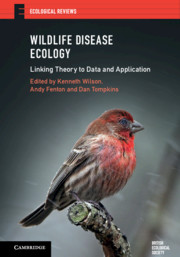Book contents
- Wildlife Disease Ecology
- Ecological Reviews
- Wildlife Disease Ecology
- Copyright page
- Contents
- Contributors
- Preface: Wildlife Disease Ecology
- Glossary of Terms
- Part I Understanding within-host processes
- Chapter one Pollinator diseases: the Bombus–Crithidia system
- Chapter Two Genetic diversity and disease spread: epidemiological models and empirical studies of a snail–trematode system
- Chapter Three Wild rodents as a natural model to study within-host parasite interactions
- Chapter Four From population to individual host scale and back again: testing theories of infection and defence in the Soay sheep of St Kilda
- Chapter Five The causes and consequences of parasite interactions: African buffalo as a case study
- Chapter Six Effects of host lifespan on the evolution of age-specific resistance: a case study of anther-smut disease on wild carnations
- Chapter Seven Sexually transmitted infections in natural populations: what have we learnt from beetles and beyond?
- Part II Understanding between-host processes
- Part III Understanding wildlife disease ecology at the community and landscape level
- Index
- Plate Section (PDF Only)
- References
Chapter Five - The causes and consequences of parasite interactions: African buffalo as a case study
from Part I - Understanding within-host processes
Published online by Cambridge University Press: 28 October 2019
- Wildlife Disease Ecology
- Ecological Reviews
- Wildlife Disease Ecology
- Copyright page
- Contents
- Contributors
- Preface: Wildlife Disease Ecology
- Glossary of Terms
- Part I Understanding within-host processes
- Chapter one Pollinator diseases: the Bombus–Crithidia system
- Chapter Two Genetic diversity and disease spread: epidemiological models and empirical studies of a snail–trematode system
- Chapter Three Wild rodents as a natural model to study within-host parasite interactions
- Chapter Four From population to individual host scale and back again: testing theories of infection and defence in the Soay sheep of St Kilda
- Chapter Five The causes and consequences of parasite interactions: African buffalo as a case study
- Chapter Six Effects of host lifespan on the evolution of age-specific resistance: a case study of anther-smut disease on wild carnations
- Chapter Seven Sexually transmitted infections in natural populations: what have we learnt from beetles and beyond?
- Part II Understanding between-host processes
- Part III Understanding wildlife disease ecology at the community and landscape level
- Index
- Plate Section (PDF Only)
- References
Summary
Parasites live and interact in multi-species communities. As these interactions are often hidden, the extent to which they occur, their relative strength and consequences are poorly understood. We review work on parasite interactions occurring in free-living African buffalo, which are distributed across the African continent and host a diversity of parasites, from bacteria and viruses to helminths. Three case studies of pairwise interactions between some of the most common and economically important parasites of buffalo shed new light on the effects of parasite interactions for individual hosts and population-level disease dynamics. Work on interactions between macro- and microparasites (common gastrointestinal worm infections and bovine tuberculosis, TB) suggests that immune responses underlie complex interactions. At individual host level, worms enhance TB infection severity, but at population level they can limit TB spread. Analysis of interactions between TB and Rift Valley Fever virus (RVFV) shows that TB presence makes increases RVFV effects. Work into how two dominant members of the worm community living in the buffalo gastrointestinal tract reassemble after perturbation reveals that the processes driving interactions between parasites can be dynamic over time. We use combined approaches to bridge the gap between individual and population scales and show how studies of natural populations can advance understanding of parasite interactions.
Keywords
- Type
- Chapter
- Information
- Wildlife Disease EcologyLinking Theory to Data and Application, pp. 129 - 160Publisher: Cambridge University PressPrint publication year: 2019
References
- 2
- Cited by



